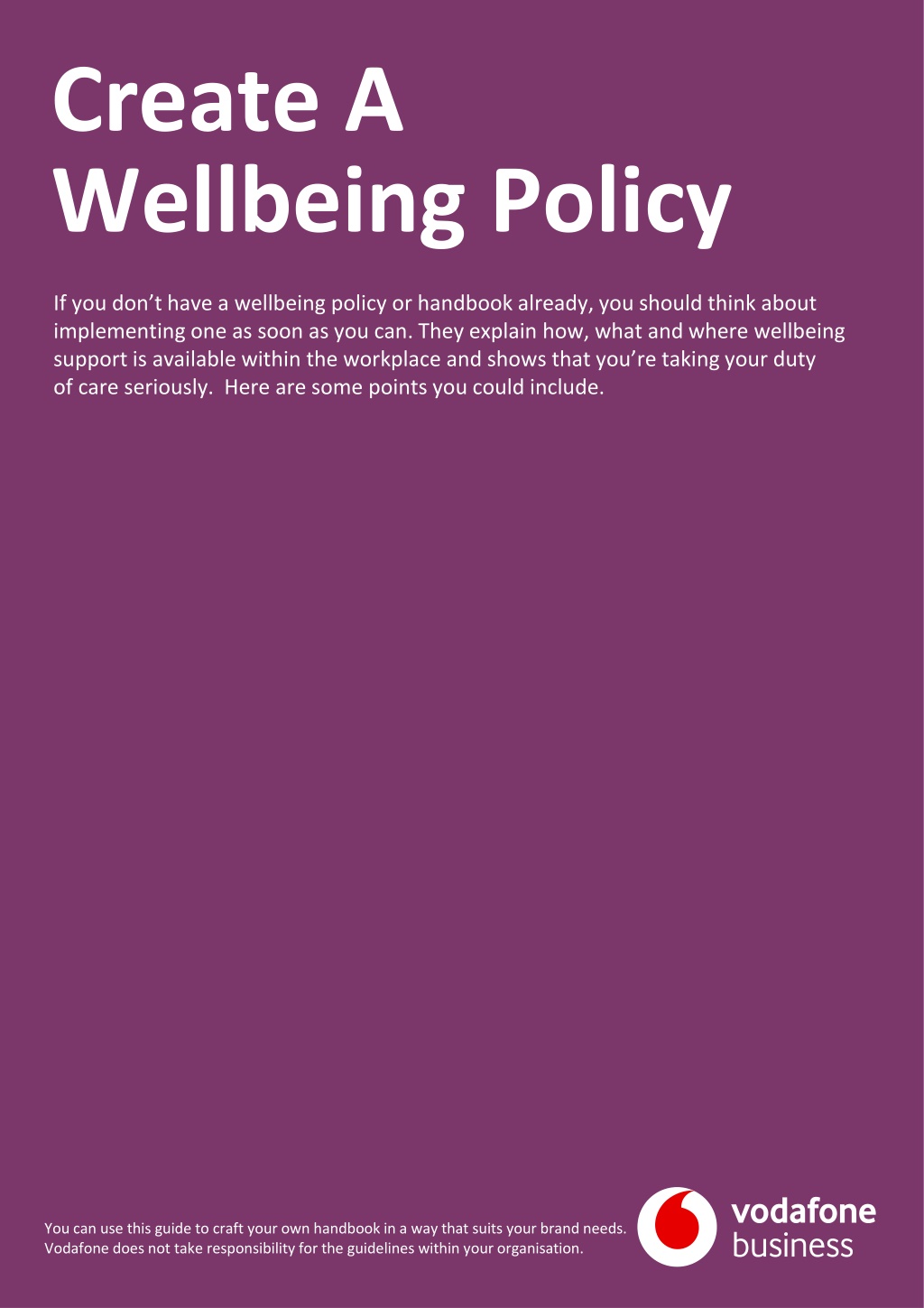Comprehensive Wellbeing Policy Guide for Employers
Craft a robust wellbeing policy to support your employees' mental and physical health. Cover areas such as flexible working options, encouraging annual leave, managing stress levels, and promoting mindfulness in the workplace. By prioritizing employee wellbeing, you can enhance productivity, morale, and overall workplace satisfaction.
Download Presentation
Please find below an Image/Link to download the presentation.
The content on the website is provided AS IS for your information and personal use only. It may not be sold, licensed, or shared on other websites without obtaining consent from the author. Download presentation by click this link. If you encounter any issues during the download, it is possible that the publisher has removed the file from their server.
Presentation Transcript
Create A Wellbeing Policy If you don t have a wellbeing policy or handbook already, you should think about implementing one as soon as you can. They explain how, what and where wellbeing support is available within the workplace and shows that you re taking your duty of care seriously. Here are some points you could include. You can use this guide to craft your own handbook in a way that suits your brand needs. Vodafone does not take responsibility for the guidelines within your organisation.
Create A Wellbeing Policy
Create A Wellbeing Policy Flexible Working Options Now that the lines between work life and home life have blurred, flexible working is more common. Adapting your policies to include flexible working won t mean a dip in productivity if it s managed well. Make your team aware of: Flexible start or finish times Option for employees to choose what working hours work best for them within the terms of your policies Working from home full-time or part-time Reassuring employees that they are trusted to work productively If flexible working isn t a realistic option for you, there are plenty of other ways you can support employee wellbeing. Encouraging Annual Leave Good wellbeing at work sometimes involves not being there. We all need a break from the everyday workload and taking time off is essential to maintain good wellbeing. Employees have a legal right to take annual leave days and should be encouraged to use their holiday entitlement every year. Find a balance of days off to keep your employees happy and have flexibility, without sacrificing on budget and productivity. In the UK, employers are required to offer 28 days of paid annual leave per year. Spending time with loved ones, doing something you enjoy, taking a holiday or simply taking time off are all part of overall wellbeing. Some employers are adding mental health days into their leave policies which give employees annual leave days dedicated to focusing on their mental wellbeing when needed. Create A Wellbeing Policy 3
Managing stress levels in the workplace We all experience stress in our lives, and this can be caused by or made worse at work. Everyone reacts and manages stress differently, but support should always be readily available. Your wellbeing policy should offer guidance on how to manage stress well. Be open to discussions about what is causing stress in the workplace. Take on feedback from employees to help lower stress levels and improve wellbeing and productivity as a result. Track what makes stress worse stressors by keeping a note of when stress levels increase, (perhaps during Christmas, the New Year, or during major changes within your company). Provide access to tools such as Headspace or Calm. Create spaces in the workplace that give employees an area to take a real break. Mindfulness Mindfulness is simply being present and having an awareness of yourself, others, and your surroundings. Mindfulness in the workplace can boost creativity, promote calm, improve focus and reduce stress. Meditation is a great way to be mindful, but there are lots of ways to practise mindfulness throughout your workday: Be present and be in the moment by taking long deep breaths. Try not to get distracted and focus on one task at a time Encourage your team to take short regular breaks throughout the day. The Pomodoro Technique is a great method to keep your workday on track. Simply work for 25 minutes then take a 5-minute break, do this 4 times then take a 15-minute break Allocate an area or room in your office as a dedicated quiet space. As an employer, what can I do right now to improve workplace wellbeing? Getting together policies and arranging training can take time, so here are 5 things you can do right now as an employer to promote healthy employee wellbeing in the workplace: Raise the profile of mental health by sharing resources, putting up posters or sharing information on your company s social media. Give recognition for good work at every opportunity. Send a nice email, give gifts or incentives, or simply tell them their good work is appreciated. Encourage your team to take real breaks. Step away from the desk, go for a walk, go out for lunch. Encourage some meetings to be taken outdoors or while on a walk. You could support this by providingearphones for your team. Encourage team building by setting up team activities, organising a team day out or an informal lunch break. This will encourage good working relationships and allow your employees to voice any concerns. Create A Wellbeing Policy 4
Promote mindfulness practices. By slowing down and taking time to reconnect throughout the day, employees can feel more at peace during their workday. Now is a good time to note that all of this is optional. Not every employee will want to engage with a wellness programme or policy and that s OK. The important thing is that your wellbeing policy is there for those that need it. Create A Wellbeing Policy 5

















































